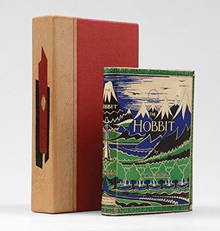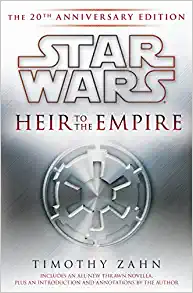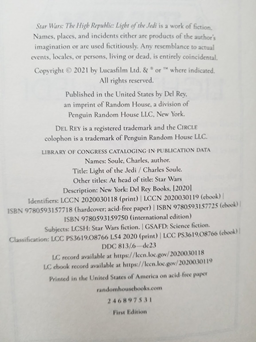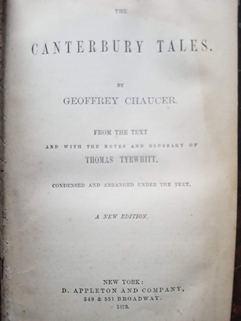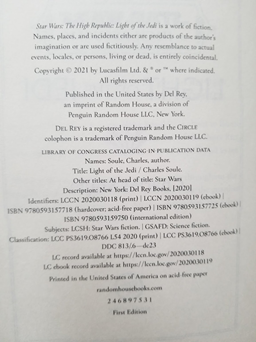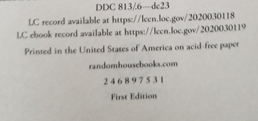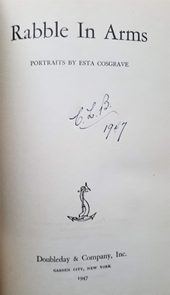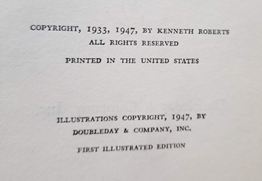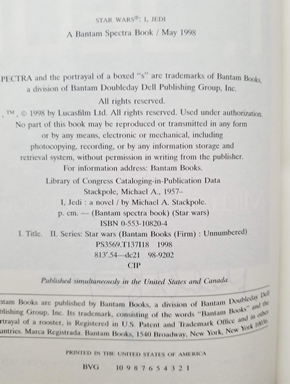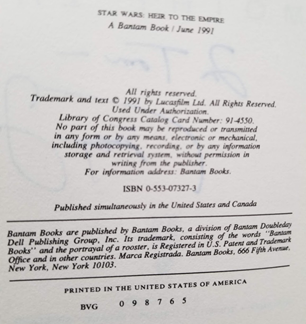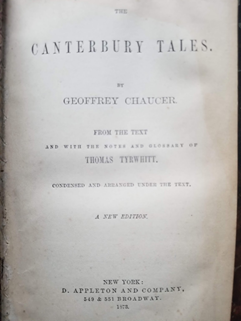Today’s publishing deep dive – first editions/printings. What the differences are, why they get confused, etc. Basics on identification (hello copyright pages!), some specific examples, and why “first edition” Star Wars novels aren’t *really* special. (1/too many)
Before we start – this is NOT an exhaustive explanation. Just a baseline explainer. There are tons of resources to explore if you’re keen to learn, particularly for collectors. And there are exceptions and side notes to almost everything. Publishing is weird. Embrace the weird.
So what is an edition and what is a printing? An edition is all copies of a book printed from the same version (or “setting”) of a book. A printing is all copies of a book printed in a batch. An edition may have many printings, but a printing belongs to a single edition.
When you print new copies of a book, that new batch is considered a new printing, but the same edition. A book only changes “editions” if the text undergoes “significant changes” before reprint. You can even change things like the cover of a book and not change the edition.
(You might also see printings referred to as “impressions” though that term was likely more popular when books were created from “impressing” on plates and engraved blocks. These days printing is the more common usage, but they mean the same thing.)
Let’s do a simple illustration before continuing, just to make things as clear as possible. Imagine we have an author, Dex, who is about to publish a book. For the initial release, we print 1000 copies. All 1000 copies are FIRST EDITIONS and constitute the FIRST PRINTING.
The book goes onsale and is successful (hooray Dex). So, we print 2000 more books to meet demand. We make no changes to the book, we just hit print. Those 2000 additional copies are also part of the FIRST EDITION, but they are now the SECOND PRINTING.
But wait, what if before we hit print on those 2000 copies, we fixed some typos and also replaced the last sentence of page 40, which was accidentally deleted in editing? Would that constitute a “new edition?” No. Changes must be more substantial than just fixing small errors.
As long as we make no significant changes, we could print millions of copies of that book and all of them would be first editions. Suddenly, having a “first edition” of Dex’s book isn’t so special. But having a copy of that “first printing” of just 1000 books does!
This is how edition/printing often get confused. A first edition sounds special, but many times what you want, or what people mean to say is actually the first printing of the first edition, sometimes referred to as a “first, first”.
(First editions also exist across formats, and different publishers. The first time a book goes from hardcover to paperback, or the first edition published in the USA if the book was originally a UK book – see LOTR, for example. For our purposes we’re not focusing on that stuff)
If this sounds a bit pedantic, it kinda is. But if you collect books, pedantry can mean a lot. And since “first edition” means something on its own, you can’t just assume it also encompasses first printing (sometimes it will). Plus, we’re talking about publishing. Words matter.
So does that mean that “first edition” is entirely overblown and always worthless, or even misleading? Not at all! Case in point, let’s talk about one of the more well-known and special first editions, THE HOBBIT.
The Hobbit was originally published in 1937. But if you buy a copy today, it isn’t the same book. It’s the second edition, first published in 1951. What changed? Content throughout was modified to bring story elements more in line with the upcoming LORD OF THE RINGS.
(By the way, that first edition of the Hobbit only had 4 printings, so most/all of them are super special. So if you have a “first, first” of the Hobbit, well, that’s pretty cool and I’d very much like to be your friend.)
So how do you tell what edition/printing you have? That can be tricky because there aren’t strict rules and it varies across publishers. But usually, it involves checking out the copyright page! That page of the book you usually skip with all the weird numbers.
Sometimes it is easy! The word “first edition” will appear. If it doesn’t you’ll want to look for the copyright year. And if there is just one, check it against the year on the title page to see if they match (most useful for older books). Some examples of both
I’m sure you’re asking, why the heck is it like this? Why don’t publishers just make this clear, or have industry standardization by now? You could ask that same question about *a lot* of things publishing does. I told you…publishing is WEIRD.
As for printings, you’ll want to consult the odd list of numbers (usually at the bottom of the page). Regardless of the order, the lowest number represents the current printing. Here are examples of a first printing, and a 5th printing. (0 counts as ten, not zero)
The way printing numbers are listed can vary too. And as you look at older books the more esoteric things can get. This copy of Canterbury Tales from 1873 has no info about printings, and not much of anything even in terms of a copyright page.
There are many rabbit holes you can fall down learning this stuff. There are full books cataloging first editions of specific novels based on typos, design quirks, and other bits of info collated over time. It can be a fun sort of treasure hunt!
As I wrap this up, a couple notes specifically about Star Wars, since that started this whole deep dive. In the entire history of Star Wars publishing (over 40 years), the number of novels that have received a true “second edition” is…one.
The only real “second edition” is the 20th anniversary of Heir to the Empire, which added annotations by the author, and a new foreword and intro. That’s it. And many Star Wars books have had many printings across formats, limited versions, etc.
One noteworthy printing is the 4th printing of Heir to the Empire. That printing has yellow “boards” under the jacket instead of blue/grey. The reason? The book reprinted so quickly that the bindery ran out of the blue/grey boards.
But overall, if you hear someone saying they have a shelf full of #StarWars first edition novels, that’s about as special as them saying that all their Star Wars books contain the phrase “a long time ago, in a galaxy far, far away….” Everyone's SW novels are first editions.
That said, books are books, and applying a fandom test based on anything – much less the funny numbers on the inside of your books – is a waste of time.
But I digress (clearly).
But I digress (clearly).
Thanks for reading. Drink some water, have a snack, don't be ashamed to love the things you love. You're valid.
(/fin)
(/fin)

 Read on Twitter
Read on Twitter